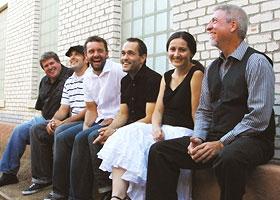2010 Homegrown Concerts
Online Archive of Past Homegrown Concerts
All of the materials from the Homegrown Concert Series
are available to visitors in the Folklife Reading Room. Selected materials
will be
made available
online as digital versions are available. Scroll down to see available webcasts and event flyer essays for the 2010 season.
 |
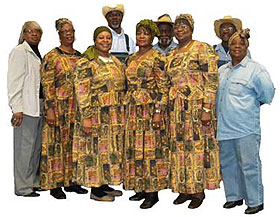
The McIntosh County Shouters |
|
 |
December 2, 2010 12:00 noon
The McIntosh County Shouters — Gullah-Geechee Ring Shout from Georgia
Read the flyer essay
View the webcast
Running time 00:57:08
The McIntosh County Shouters is a ten-member Gullah-Geechee group that began performing professionally in 1980. They have educated and entertained audiences around the United States with the “ring shout,” a compelling fusion of counterclockwise dance-like movement, call-and-response singing, and percussion consisting of hand claps and a stick beating the rhythm on a wooden floor. African in its origins, the ring shout affirms oneness with the Spirit and ancestors as well as community cohesiveness. The ring shout was first described in detail during the Civil War by outside observers in coastal regions of South Carolina and Georgia. Its practice continued well into the 20th Century, even as its influence was resounding in later forms like spiritual, jubilee, gospel and jazz. By the late 20th century, the ring shout itself was presumed to have died out until its rediscovery in McIntosh County in 1980; thus, the beginning of the McIntosh County Shouters. The group was awarded the NEA National Heritage Fellowship in 1993, and were selected as Producers of Distinction and Founding Members of the “Georgia Made Georgia Grown Program,” in 2009. Their performances include the National Black Arts Festival, of Smithsonian Folklife Festival, World Music Institute, and Sound Legacies at Emory University. The group has been featured in magazines and documentaries, including HBO's Unchained Memories.
November 17, 2010 12:00 noon
Carlos Nakai — American Indian Flute Music from Arizona
Read the flyer essay
View the webcast Running Time 00:57:42
Of Navajo-Ute heritage, R. Carlos Nakai is the world's best known performer of Native American flute music. He began his musical studies on the trumpet, but a car accident ruined his embouchure. He was given a traditional cedar flute as a gift and challenged to master it, which led to his current path. Nakai views his cultural heritage not only as a source and inspiration, but also as a dynamic continuum of natural change and adaptation, subject to the artist's expressive needs. Nakai's first album, Changes, was released in 1983, and since then he has released over thirty-five albums. He gives educational workshops and residencies, and has appeared as a soloist throughout the United States, Europe, and Japan. He has worked with Grammy-winning flutist Paul Horn, guitarist William Eaton, and composer James DeMars, among many others. The famed American choreographer Martha Graham used Nakai's second album, Cycles, in her work Night Chant. Nakai also contributed music to the major motion pictures New World and Geronimo.
 |

The Not Too Bad Bluegrass Band from Indiana |
|
 |
October 13, 2010 12:00 noon
The Not Too Bad Bluegrass Band — Bluegrass from Indiana
Read the flyer essay
View the Webcast Running time 1:03:00
The Not Too Bad Bluegrass Band formed in 1987, playing local venues around Bloomington, Indiana. Original members included Jeff White, who went on to play with superstars like Alison Krauss and Vince Gill; singer-songwriter Bob Lucas; and Lisa Germano, who later played fiddle with John Mellencamp's band. The current members have their own musical history. Brian Lappin played with bluegrass legends Jimmy Martin and Earl Taylor, and the bands The Ragin' Texans and The Crawdads. His tasteful banjo playing reflects the solid influences of Earle Scruggs and J.D. Crowe. Doug Harden has played mandolin since 1969. His early years were spent at the old Bean Blossom Jamboree barn, and in the Brown County Band. Doug has also spent time in the original Kentucky Ramblers and the band Pine Mountain. Greg Norman started at a local jam session and later joined the Off the Line bluegrass band and singer-songwriter Janne Henshaw's band. Kent Todd was trained in classical violin, and was steered toward bluegrass by his father Scott, also a bluegrass musician; he has played with Bill Grant and Dehila Belle, Michael Cleveland and the Blue Hollow Band, Gary Brewer and the Kentucky Ramblers, and currently is also a member of the Troubled Waters Band. The youngest member of the NTBBB, Brady Stogdill, is a member of the original International Bluegrass Music Association's Young Acoustic All Stars; his father Dean was a great banjo player, and he has learned to play almost anything with strings on it.
September 15, 2010 12:00 noon
Marimba Linda Xelajú: Guatemalan Marimba Music from Maryland
Read the flyer essay
View the webcast Running time 00:53:03
All of the materials from the Homegrown Concert Series
are available to visitors in the Folklife Reading Room. Selected materials
will be
made available
online as digital versions are available. Scroll down to see available webcasts and event flyer essays for the 2010 season.
At the core of Guatemala's musical traditions is the marimba, an instrument with West African roots that can be found throughout northern Central America and southern Mexico. The marimba is Guatemala's official national instrument, and government ordinances require broadcasting of marimba music on a daily basis. The contemporary marimba's construction is similar to that of the xylophone. Its key arrangement resembles that of a piano, with the "black keys" set above and behind the "white keys." Some of the larger marimbas may be played by as many as eight musicians, each using two or more rubber-tipped mallets. On early marimbas, each key has its own gourd resonator underneath. On more modern instruments, these gourd resonators have been replaced with tubes made of wood, metal or even PVC. The tubes on a Guatemalan marimba have a tiny hole at the bottom, over which a piece of intestinal membrane or skin is stretched. When a key is struck, the membrane makes a loud buzzing sound while the resonator amplifies the key's tone.
Marimba Linda Xelajú is family group that honors both tradition and innovation in its interpretation of the Guatemalan marimba. In Guatemala, playing the marimba has traditionally been a male pursuit. But Robert Girón has chosen to share his love and knowledge of the marimba with his daughters as well as his son, and the cherished music of his homeland today continues within a new context and community. In 1995, Girón had a beautifully ornate marimba hand-built in Guatemala by Nojobel Salazar, and brought it to the United States. The whole family plays this fine instrument at once. Robert Sr. and his son Robert play treble. His daughters Beverly and Jennifer play melody and harmony. Marimba Linda Xelajú has performed extensively throughout the Washington D.C. area venues including the Smithsonian Folklife Festival, the Museum of the American Indian, and at the National Zoo.
 |
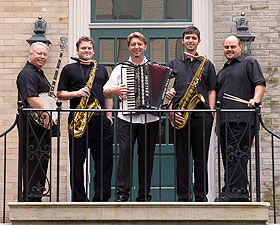
The Steve Meisner Band at the Library of Congress. Left to right: Denny Anderson, Jason Goldsmith, Steve Meisner, Austin Meisner, and Christopher Doszak. Photo by Megan Halsband, 2010. |
|
 |
August 25 , 2010 12:00 noon
The Steve Meisner Band: Traditional and Contemporary Polka from Wisconsin
Read the flyer essay
View the webcast Running time 01:04:52
Steve Meisner is a multi-talented musician, composer and arranger, and a leading figure in American Polka music. He began playing the accordion at the age of five with his father, the late Verne Meisner, who had a successful music career for over fifty years. Since then, he has brought his brand of traditional American polka into the 21st century with a fresh spark and swing, while retaining the music's roots. He has played with the nation's top accordionists, including Myron Floren, Frank Yankovic, and Joey Miskulin. He performs nationally and internationally, averaging two hundred performances a year; venues have included the Lawrence Welk Theater in Branson, Missouri, and the Smithsonian Folklife Festival on the National Mall in Washington, D.C. Steve has received numerous awards and nominations, including inductions to the Ironworld Polka Hall of Fame and the Wisconsin Polka Hall of Fame. For more information, visit Steve Meisner's website.
July 14, 2010 12:00 noon
Amuma Says No: Traditional and Contemporary Basque Music from Idaho
Read the flyer essay
View the webcast Running time 0:59:42
Amuma Says No is among the best-known bands playing Basque music in America today. The band brings together the best of traditional trikitixa — a duo of accordion and tambourine–with a modern rhythm section and songs sung in the Basque language, Euskara. Based in Boise, Idaho, home of the largest community of Basques outside their home provinces along the French and Spanish Pyrenees, "ASN" have brought their energetic, exciting and contemporary arrangements of Basque music to Basque festivals and events throughout the west, including Idaho, Nevada, and Oregon. Jill Aldape, Dan Ansotegui, Sean Uranga Aucutt and Spencer Basterrechea Martin, the founders, are second and third generation Americans. They grew up dancing with the Oinkari Basque Dancers and listening to Basque artists like Jimmy Jausoro and Domingo Ansotegui. Joined in the current lineup by Rod Wray and Micah Deffries, they present a timeless traditional repertory with a touch of twenty-first century rock, pop and jazz. For more information, visit the Amuma Says No website.
 |
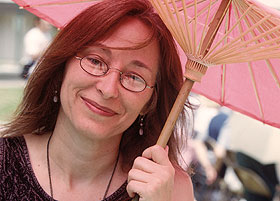
Marce Lacouture. Photo by Philip Gould. |
|
 |
June 23, 2010 at noon
Marce Lacouture with David Greely and Kristi Guillory — Cajun Music from Louisiana
Read the flyer essay
View the webcast Running time 1:03:00
Marce Lacouture grew up in Texas and Louisiana. She began singing professionally in Austin folk and rock bands, and in 1984 formed a duo with legendary singer-songwriter Butch Hancock. Together they recorded two collaborative albums, Yella Rose and Cause of the Cactus, and shared stages with such friends as Lyle Lovett, Lucinda Williams, Nanci Griffith, and Jimmie Dale Gilmore. In the 1980s, Marce headed to Louisiana to explore her Cajun heritage. Her search led to a years-long apprenticeship with traditional Louisiana French ballad singers Lula Landry and Inez Catalon. Marce's ability to bring alive the ancient ballads and home traditions of Louisiana makes her a sought-after performer and teacher. Marce's first solo recording, La Joie Cadienne, (Cajun Joy), is a loving tribute to her mentors.
 |
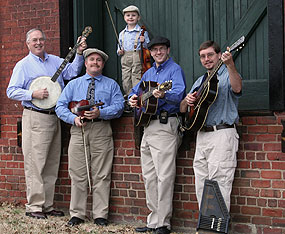
The New North Carolina Ramblers. |
|
 |
May 19, 2010 at noon
New North Carolina Ramblers — Old-Time Stringband Music
Read the flyer essay
(webcast forthcoming)
The New North Carolina Ramblers is an old-time string band whose four musicians span almost three generations. The band was formed in the late 1960s by Kinney and Doug Rorrer, nephews of Charlie Poole and Posey Rorer, who were the original North Carolina Ramblers in the 1920s. Over the years, the New North Carolina Ramblers have featured many different local old-time musicians, but Kinney Rorrer has remained with the group since its genesis. Today, the band consists of Kinney, Kirk Sutphin, Darren Moore, and Jeremy Stephens. Kinney plays the banjo in the old-time three-finger picking style of Charlie Poole, and Kirk Sutphin can play the fiddle with same graceful touch that Posey Rorer had. They perform songs and tunes from the repertoire of Charlie Poole, and from many other old time artists. Darren Moore and Jeremy Stephens add their own take on classic Carter Family material. The New North Carolina Ramblers offer a variety of old time styles with a touch of down-home comedy.
 |
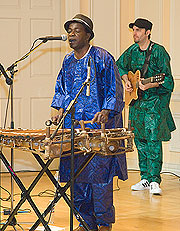
Balla Kouyaté in concert at the Library of Congress. |
|
 |
April 28, 2010 - 12:00 noon
Balla Kouyaté and World Vision: Traditional Malian Music from Massachusetts.
Read the flyer essay
View the webcast Running time 01:08:18
Balla Kouyaté is a griot and virtuoso player of the balaphon, the ancient West African ancestor of the xylophone. Played with mallets, the balaphon is made up of wood slats of varying lengths. Underneath, two rows of calabash gourds serve as natural amplifiers. To say that Kouyaté was born into a musical family is an understatement. His family lineage goes back over 800 years to Balla Faséké, the first of an unbroken line of djelis, or griots, in the Kouyaté clan. The members of this family are regarded as the original praise-singers of the Malinké people, one of the ethnic groups found across much of West Africa. Djelis are the oral historians, musicians and performers who keep alive and celebrate the history of the Mandé people of Mali, Guinea and other West African countries. Kouyaté frequently performs traditional music at weddings, baptisms, and other domestic ceremonies within the West African immigrant communities of Boston, New York City, and beyond, and also leads the fusion group World Vision. He often accompanies kora master Mamadou Diabate, 2009 Grammy winner in Traditional World Music, and in 2004 joined NEA National Heritage Fellow Sidiki Cond Kouyaté for a month-long residency at Carnegie Hall. In 2010, Balla Kouyaté was awarded a Massachusetts Cultural Council Fellowship in the Traditional Arts. For more information, visit the Balla Kouyaté website.
|
![]()
![]()
![]()






